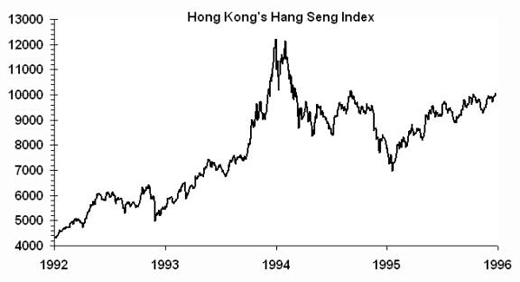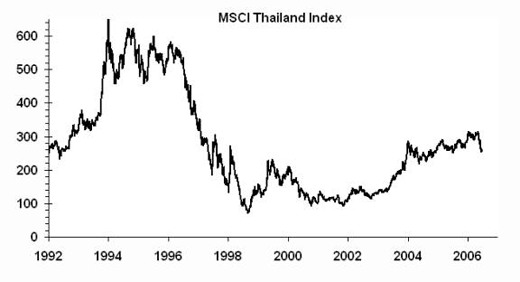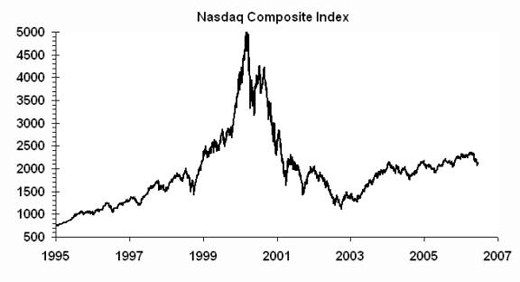| Home | About Us | Resources | Archive | Free Reports | Market Window |
First the Guillotine, Then the SandpaperBy
Wednesday, June 28, 2006
I first felt the guillotine and the sandpaper back in 1993-1994... I was making what seemed like a fortune. You see, investors everywhere wanted “China plays” back then. I couldn’t have been in a better place... I was a broker specializing in foreign stocks and bonds. Then the dream crashed... the guillotine came. In February 1994, Hong Kong’s Hang Seng Index fell from 12,000 to 9,000. By March, I didn’t want to answer my phone. I wanted to hide under my desk. The chart below shows the guillotine (starting in late 1997), followed by the sandpaper (the next ten years).
While you might not have faced the guillotine and the sandpaper in Asia, chances are, the guillotine got you in 2000 in U.S. stocks, and you’ve been sandpapered since...
Bob was talking about the decade of the 1970s... a decade that sandpapered stock investors to death. His quote at the top of this essay is from page 45 of Maggie Mahar’s outstanding book, Bull! A History of the Boom, 1982-1999. Later on that page, Maggie says, “Most investors who succeeded in the seventies did it by abandoning U.S. stocks and bonds for other types of investments... Gold for instance, rose by an astounding 19.4 percent a year from 1968 to 1979; diamonds climbed 11.8 percent annually, while real estate became the favorite inflation hedge among small investors, with the price of single-family homes rising 9.6 percent.” In the decade of the 1970s, stocks were dogs. Real estate, gold, and other “tangible assets” were the places to be. In this decade, the story is the same. Stock investors have been sandpapered to death. Since we haven’t hit the “hopeless” phase, as Farrell describes at the top of this letter, chances are there’s more sandpapering to go through in stocks. Meanwhile, real estate has soared. Gold too. And other tangible assets are just starting their moves. In recent years, I’ve continually reduced the percentage of stocks in my portfolio, and increased my exposure to tangible assets. It’s really been the right thing to do. I believe that it’s still very early in this trend. Hundreds of percent gains are still on the table here, I believe. As investors in stocks continue to get sandpapered, more and more investors will finally opt out of stocks, and look for something else. I think, just like the 1970s, tangible assets will become popular once again. You should consider increasing your exposure to tangible assets too... Good investing, Steve Market NotesSEND US YOUR TAKE ON CRUDE OIL… As DailyWealth mentioned in our June 19th issue, May’s global sell-off pummeled nearly every asset in the world. Gold dropped $200 an ounce… housing stocks plunged… emerging markets fell 25%. The Nasdaq was clobbered. One market refused to budge however… the market for crude oil. While investors lost billions in stocks and gold, the global correction barely managed to push crude oil below $70 a barrel. Is this lack of price weakness a bullish sign for crude oil? Or is oil ready to sink lower? Send us your opinion at [email protected]. -Brian Hunt |
Recent Articles
|




